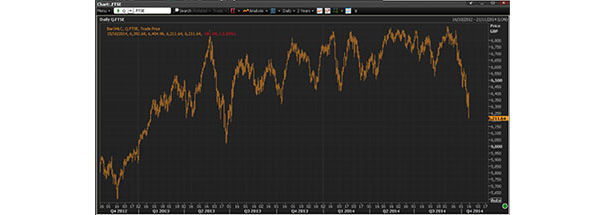
Since the middle of September, the FTSE 100 has been on an almost unchecked downward trajectory amid concerns over a stagnant global economy, said to be influenced by political, social and economic instability around the world.
Understandably, investors can be reticent to commit long term in a climate that seems particularly volatile. However, markets by their very nature are cyclical, and a falling market presents potentially greater value to the investor who is committed for the long term. By long-term, this would generally be considered to be a minimum 5-7 years. Any time horizon of less than 5 years from the outset would be considered unsuitable for stock market investing where there is insufficient capacity on the part of the investor to bear potential losses.
Investing in a falling market appears to be a counter-intuitive thing to do, but can lead to positive outcomes where ‘value’ is perceived to have been created. A typical reaction to market volatility is usually to buy during a market upswing, and sell during a downswing. Taking a ‘value’ approach to investing requires a bit more drilling down into the fundamental measures of individual stocks. A low price/earnings ratio of a stock for instance, might mean that a company has fallen out of favour in the market compared to its nearest rivals and therefore be considered something of a bargain. There are collective investment funds which specialise in this type of approach, and the skill and judgement of the fund manager is paramount when making these kinds of investment decisions.
An alternative to investing a lump sum at the outset, particularly in a falling market, is to commit a fixed regular sum over a period of time, and this can help manage the risks of stock market investment. Known as ‘pound-cost averaging’, the process smoothes out the highs and lows of the market or share being invested. Shares are purchased for a fixed monetary sum at different prices on a regular (typically monthly) basis. The lower the share price, the more shares purchased with the fixed monetary sum. The result is the investor holds numerous tranches of stock, each with a different rate of growth reflecting the actual time invested in the market, and the price purchased for each tranche of stock.
As well as a long term investment strategy, it is worth taking the extra precaution, particularly with large sums, of buying into a diverse range of assets in order to spread risk. The onset of globalisation has made this more difficult to achieve since the world’s major economies are moving increasingly in step with each other. However, diversity can still be found and many low cost funds from the likes of Vanguard for instance, provide access to a wide geographical range of assets as well diversity by asset class eg bonds and equities.
With any stock market related investment, the guiding principle will always remain the same; ‘The value of investments and any income will fluctuate and you may not get back the full amount invested’.


Comments